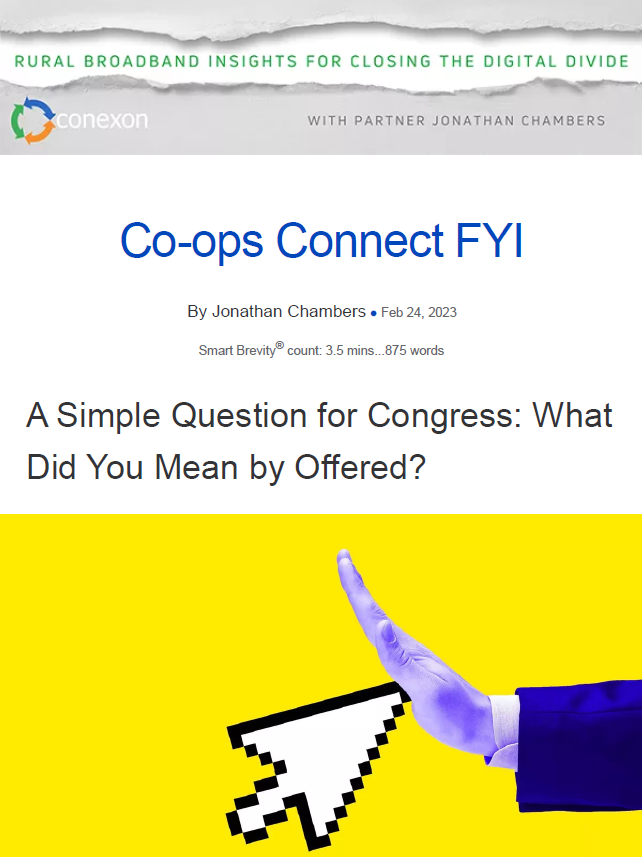A Simple Questions for Congress: What Did You Mean by Offered?
February 24, 2023
The Infrastructure Act, which created the BEAD program, limits areas eligible for funding to unserved and underserved broadband serviceable locations.
It defines unserved locations as:
UNSERVED LOCATION.—The term ‘‘unserved location’’ means a broadband-serviceable location, as determined in accordance with the broadband DATA maps, that— (i) has no access to broadband service; or (ii) lacks access to reliable broadband service offered with— (I) a speed of not less than— (aa) 25 megabits per second for downloads; and (bb) 3 megabits per second for uploads; and (II) a latency sufficient to support real-time, interactive applications. (Note: Emphasis added.)
Underserved locations are those that lack access to reliable broadband service offered with a speed of not less than 100 Mbps download and 20 Mbps upload.
The big question: What did Congress mean by offered?
The answer will either solve or perpetuate one of the two systemic reasons for the digital divide.
Two Systemic Reasons for the Digital Divide
First: I’ve described previously the problem of perpetual underbuilding by incumbents working in concert with the government agencies.
Second: How the FCC and NTIA measure things. Things like speed.
Put simply, the public has grown frustrated with a different type of divide: the divide between advertised speed and delivered speed.
- This divide has been perpetuated by the agencies responsible for policing the industry.
- Most of the brouhaha over the previous and current version of the National Broadband Map relates to the question asked by the FCC in previous Form 477s and the current Broadband Data Collection.
1) Internet service providers are asked to identify each location where they provide service.
2) ISPs are then asked to indicate the technology used and the maximum advertised speed.
Why it matters:
Maximum advertised speed and delivered speed are not the same.
If the difference were minor, like the classic caveat “Your mileage may vary,” it wouldn’t be a significant issue.
But when a once-in-a-generation effort to solve the digital divide is at stake, maybe we should look more closely at the variance.
More Big Questions
As I wrote last week, T-Mobile’s speed claims in its advertising were challenged by Comcast in a complaint to the BBB.
- The BBB then found T-Mobile should not claim its home internet access is “fast,” “high-speed,” or “reliable.”
- In other words, T-Mobile’s home internet service should not be considered broadband under the Infrastructure Act’s definition.
- The 50+ million locations claimed to be covered by T-Mobile, particularly in rural areas, should not be counted as served.
- Yet, as things stand, unless the FCC does something about it, T- Mobile’s unfounded claims would wipe out BEAD funding in rural areas. The FCC says it is investigating.
The bottom line:
Should we all be filing complaints to the BBB — or will the FCC, NTIA, FTC, state broadband offices, or state attorneys general do their jobs?
To me, the question comes back to Capitol Hill.
Did Congress intend the Infrastructure Act to exclude from BEAD funding those locations where 25/3 Mbps or 100/20 Mbps is offered, but not delivered?
Two Solutions
If offered implies delivered, what are rural residents to do about the vast difference between promise and experience?
I propose two potential solutions:
1) The FCC could change or include in the broadband data collection that ISPs identify the delivered speed, not the maximum advertised speed.
- Any recipient of FCC high-cost subsidies is familiar with the speed test protocols of the FCC. Through periodic testing using approved equipment, ISPs must deliver speeds that are at least 80% of the required speed at least 95% of the time.
- For example, a company like Charter, which won RDOF funding at the 1 Gbps/500 Mbps tier, must show actual download speeds of at least 800 Mbps and upload speeds of at least 400 Mbps. It must do so periodically through broad-based testing.
- Why not apply the same standard to those who seek to preclude funding for broadband in rural areas?
- For example, T-Mobile could be asked to demonstrate through the same FCC protocols that its service is at least 80% as fast as it claims to be.
2) The FCC could dust off its Measuring Broadband America program and verify speed claims by carriers and technologies and then offer those results to states for implementation of the BEAD program.
- This option is my preference.
- The FCC is our nation’s expert agency. Its facilities in Gettysburg could be put to good use in this essential and time-critical task.
The final word: The meaning of “offered.”
While I don’t expect anyone in Congress to answer my initial question, I think it is worth clarification.
- I spent eight years working on Capitol Hill. As Republican staff director of the Senate Commerce Committee, I had a small role in crafting some of the nation’s seminal laws governing the telecommunications and broadband industry.
- I know statutory language is left purposefully vague at times.
In the cartoons I read as a kid, Lucy offered to let Charlie Brown kick afootball. We all know how that worked out.

